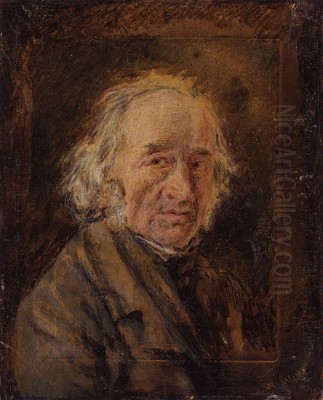
William Henry Hunt stands as a pivotal figure in the history of British art, particularly celebrated for his mastery of the watercolour medium during the 19th century. Born in London in 1790 and passing away in 1864, Hunt carved a unique niche for himself, transitioning from landscape painting to become one of the most revered still-life artists of the Victorian era. His work is characterized by an extraordinary attention to detail, a profound sensitivity to colour and light, and a deep appreciation for the humble beauty of nature. So renowned was he for his depictions of bird nests that he earned the affectionate nickname "Bird's Nest Hunt."
Early Life and Artistic Formation
William Henry Hunt entered the world on March 28, 1790, in Old Compton Street, London. His father was a tin-plate worker, and contrary to some erroneous accounts, his mother was English. From a young age, Hunt faced physical challenges; he suffered from a weakness and deformity in his legs, which precluded him from pursuing more physically demanding trades. However, this limitation perhaps steered him towards his innate artistic talents, which his parents recognized and encouraged.
Around 1805 or 1806, recognizing his potential, Hunt's father allowed him to pursue art formally. He was apprenticed to the prominent landscape painter and influential teacher, John Varley. Varley, known not only for his own accomplished watercolours but also for his association with figures like the visionary artist William Blake, provided Hunt with a solid foundation. Hunt remained under Varley's tutelage for five or six years, a period crucial for his development.
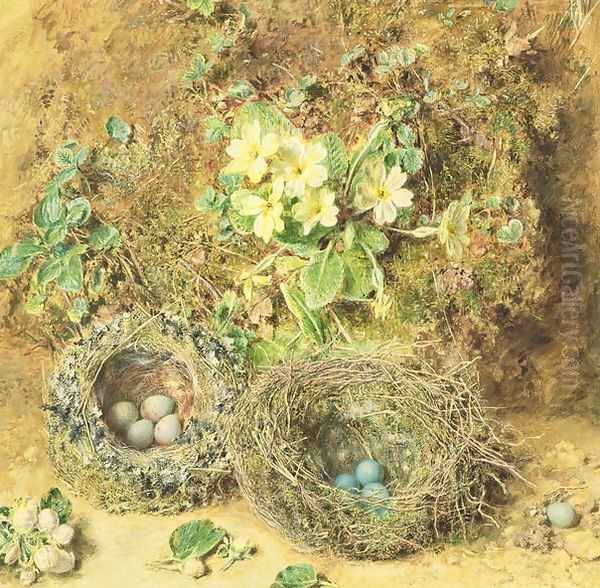
During his time with Varley, Hunt worked alongside other aspiring artists, including John Linnell, who would also achieve significant fame. This environment fostered learning and artistic exchange. Hunt also benefited from the circle around Dr. Thomas Monro, a physician, collector, and important patron of young artists. Monro's home, particularly his country house at Bushey, Hertfordshire, served as an informal academy where artists could study and copy works from his collection. Hunt associated with Monro and artists in his circle, such as Henry Edridge, further broadening his artistic horizons. His early promise was evident when, in 1807, he exhibited three oil paintings at the prestigious Royal Academy of Arts, shown alongside the work of his master, Varley.
Transition to Still Life and Technical Mastery
While Hunt initially followed his master Varley into landscape and architectural subjects, often rendered with bright, clear colours typical of the earlier watercolour tradition, his artistic path gradually shifted. Over time, he moved away from expansive views and focused increasingly on intimate studies of nature and rustic life, particularly still life. This shift may have been partly influenced by his physical limitations, which made extensive outdoor sketching expeditions more challenging, but it also clearly stemmed from a personal fascination with the intricate details of the natural world.
Hunt became a consummate master of watercolour technique, exploring the full potential of the medium in ways that were innovative for his time. He moved beyond the traditional reliance on pure transparent washes, embracing a more complex and textured approach. He skillfully employed bodycolour (gouache, or watercolour mixed with white pigment) to achieve opacity and solidity, creating vibrant highlights and rich, deep tones that contrasted effectively with the luminous transparency of pure watercolour.
His technical repertoire was diverse. Hunt was known to use stippling (applying paint in tiny dots) to build up form and texture. He experimented with different paper surfaces, often preferring slightly rougher textures that could hold the pigment and enhance the visual effect. Crucially, he pioneered or popularised techniques such as scratching or scraping out highlights from the painted surface, revealing the white paper beneath to represent sparkle on fruit or the delicate edge of a feather. He also utilized gum arabic mixed with his pigments to increase their brilliance and transparency. These methods allowed him to render the varied textures of fruit skin, the downiness of feathers, the fragility of eggshells, and the bloom on grapes with astonishing realism.
Signature Subjects: The Intimacy of Nature
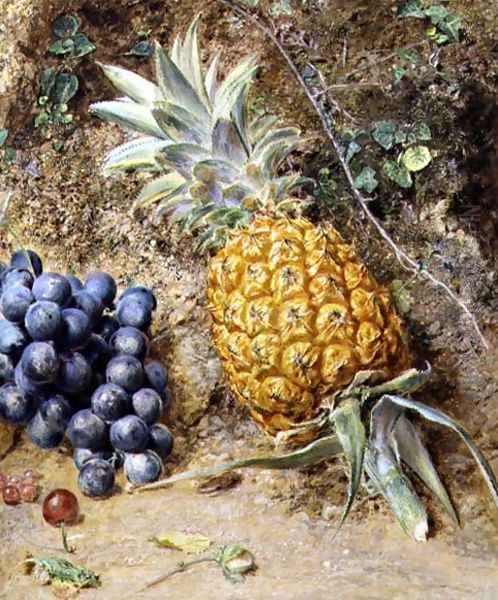
It was in the realm of still life that William Henry Hunt truly excelled and secured his lasting reputation. He turned his meticulous gaze upon the seemingly simple objects of the natural world, finding profound beauty in their detail. His most celebrated subjects include arrangements of fruit – luscious grapes, plums often depicted with their powdery bloom intact, peaches, apples, and pears. He rendered these with such fidelity that viewers could almost feel their texture and weight.
Flowers were another favourite subject, often depicted with botanical accuracy yet imbued with a sense of life and freshness. However, he is perhaps most famously associated with his depictions of bird nests, often shown cradling delicate, speckled eggs. These works, which earned him the "Bird's Nest Hunt" moniker, showcase his incredible ability to capture the intricate construction of the nests – the interwoven twigs, moss, and feathers – and the fragile beauty of the eggs within. These intimate portrayals of nature resonated deeply with Victorian sensibilities, which valued detailed observation and found moral or sentimental value in the natural world.
His representative works in this genre are numerous and highly prized. Titles like Primroses and Birds' Nests, Apples, Cherries and Bird's Nest, Grapes, Melon, and Plums, and studies simply titled Grapes or Watermelon exemplify his focus. These paintings are not mere copies of nature; they are carefully composed studies of colour, light, and texture, demonstrating Hunt's exceptional powers of observation and his ability to translate those observations into compelling works of art. His approach stood in contrast to the broader, more atmospheric effects sought by earlier watercolour giants like J.M.W. Turner or Thomas Girtin, focusing instead on intense, localized detail.
Rustic Figures and Genre Scenes
Alongside his celebrated still lifes, Hunt also produced a significant body of work depicting figures, often drawn from rural life. These were typically single figures or small groups, frequently featuring children, farm labourers, or humble folk engaged in everyday activities. Works such as Boy and a Goody (possibly also known as Boy with a Goat), The Irish Orange Seller, and the intriguingly titled A Brown Study (often featuring a boy in contemplative pose, sometimes with fruit) fall into this category.
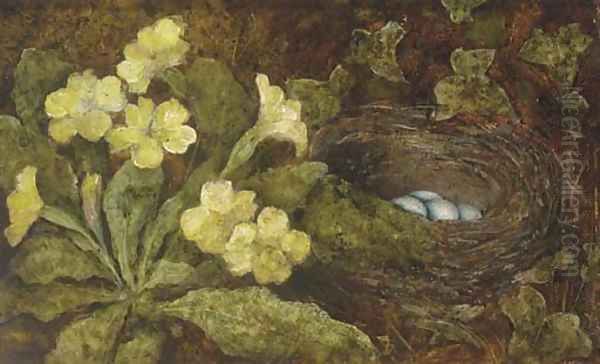
In these figure studies, Hunt applied the same principles of close observation and detailed rendering that characterized his still lifes. He captured the textures of clothing, the character in a face, and often imbued the scenes with a gentle humour or pathos. These works tapped into a popular Victorian interest in genre scenes and depictions of rustic simplicity, offering charming, relatable vignettes of everyday life. While perhaps less technically dazzling than his fruit and nest studies, these figurative works demonstrate his versatility and his sympathetic eye for human subjects. They connect him to a broader tradition of British genre painting, seen in the work of artists like William Mulready, who was also associated with John Varley and the Monro circle.
Professional Recognition and Ruskin's Acclaim
Hunt's dedication and unique talent did not go unnoticed. He became closely associated with the Society of Painters in Water Colours (initially founded in 1804, later becoming the Royal Watercolour Society or OWS). He was elected an Associate member in 1824 and achieved full membership in 1827. He was a prolific contributor to the Society's annual exhibitions for nearly four decades, showcasing hundreds of his meticulously crafted works and building a loyal following among collectors and critics.
His patrons included members of the aristocracy, such as the Earl of Essex and the Duke of Devonshire, indicating the high regard in which his work was held. However, his most influential champion was undoubtedly the pre-eminent Victorian art critic, John Ruskin. Ruskin held Hunt's work in the highest esteem, seeing in his intense naturalism and technical brilliance the embodiment of artistic truth. Ruskin not only praised Hunt lavishly in his writings but also took drawing lessons from him, eager to understand his methods firsthand.
Ruskin famously declared Hunt to be among the greatest colourists of the entire British school of painting and, perhaps hyperbolic but indicative of his admiration, described him as "the finest painter of still life that ever existed." Ruskin particularly admired Hunt's ability to capture the essential character and beauty of natural objects through painstaking observation and precise execution. This powerful endorsement significantly boosted Hunt's reputation and influenced how his work was perceived and valued. Ruskin's promotion of truth to nature, exemplified by Hunt's work, also laid some groundwork for the ideals embraced by the Pre-Raphaelite Brotherhood.
Influence and Enduring Legacy
William Henry Hunt's impact on British art extended beyond his own lifetime. He played a crucial role in elevating the status of watercolour painting, demonstrating through his own work that it was capable of achieving levels of detail, richness, and complexity comparable to oil painting. His technical innovations, particularly his use of bodycolour and textural effects, expanded the expressive possibilities of the medium for subsequent generations.
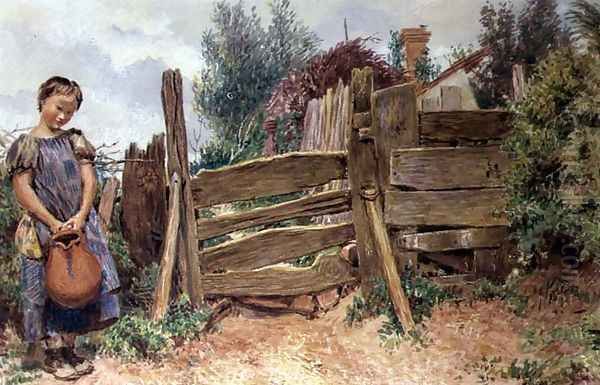
His commitment to detailed naturalism resonated strongly with the Pre-Raphaelite Brotherhood, founded in 1848. Although Hunt was not formally part of the group, his work, championed by Ruskin, provided a model of the intense observation and meticulous rendering of detail that artists like Dante Gabriel Rossetti and John Everett Millais (in his early phase) strove for. Hunt's influence can be seen as part of a broader Victorian fascination with scientific observation and the faithful depiction of the natural world.
While stylistically distinct, other contemporaries engaged with nature in intense ways, such as Samuel Palmer, whose visionary landscapes share a certain intensity of focus, albeit channelled towards more mystical ends. Hunt's dedication to still life also placed him in dialogue with other specialists like George Lance, who worked primarily in oils but shared an interest in fruit and inanimate objects, offering a point of comparison in a different medium. Furthermore, Hunt's charming rustic scenes contributed to the popularity of genre subjects, a field explored by many Victorian artists, including later popular watercolourists like Myles Birket Foster, who captured an idealized vision of rural England. Hunt's legacy lies in his unique fusion of technical virtuosity and humble subject matter, creating works that continue to fascinate with their jewel-like precision and quiet beauty. His paintings remain highly sought after and are held in major collections, including the Victoria and Albert Museum and galleries throughout the UK.
Later Years and Conclusion
In his later years, William Henry Hunt settled in the coastal town of Hastings, Sussex, continuing to paint with dedication. His personal life appears to have been relatively quiet and focused on his art; despite an erroneous claim in one source, reliable biographical accounts state that he never married. His life was dedicated to his craft, finding fulfillment in the patient observation and rendering of the world around him.
William Henry Hunt passed away in London on February 10, 1864, following a stroke. He left behind a remarkable body of work that secures his place as one of the most distinctive and accomplished watercolourists of the 19th century. From his early training under John Varley to his mature masterpieces of still life, Hunt forged a unique artistic identity. Celebrated for his unparalleled skill in capturing the minute details and vibrant colours of nature, particularly fruit, flowers, and his signature bird nests, he earned the admiration of critics like John Ruskin and influenced subsequent generations of artists. "Bird's Nest Hunt" remains a testament to the power of focused observation and technical brilliance, a master who found profound beauty in the small, often overlooked corners of the natural world and elevated them through the delicate yet powerful medium of watercolour.